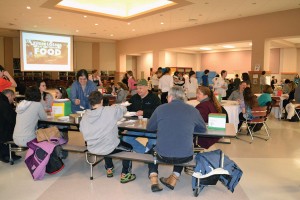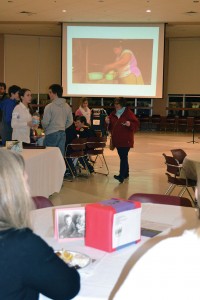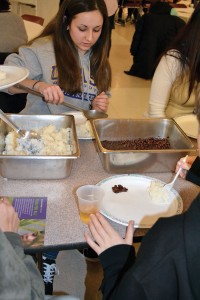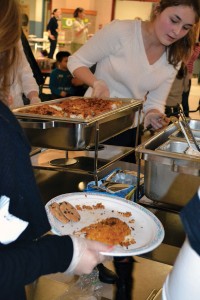Malnutrition is the leading cause of child mortality, accounting for one-third of all deaths worldwide of children under the age of five. One in eight people on Earth goes to bed hungry every night according to Oxfam, an international confederation of 17 organizations that work together to help create lasting solutions to the injustice of poverty.
The main message driven home the night of February 13 at the Old Rochester Regional Junior High School’s Oxfam Banquet fundraising event was that world hunger is not about a lack of food, nor is it about having enough resources for the entire world’s population to survive.
“Hunger is about power,” read the dozens of Oxfam factsheets placed on the tables throughout the cafeteria.
Companies and governments control the global food system, says Oxfam, “and they determine who eats and who doesn’t.”
Exacerbating the problem is climate change, the underlying theme of the event, which has dramatically increased throughout the planet; but nowhere more often are the effects of the changing climate witnessed than in developing countries.
The poorest of the human population are at the very frontlines of global climate change, with extreme weather conditions disrupting agriculture and drying up water supplies, while driving up food prices and plunging millions into poverty and hunger.
As the guests arrived, each was handed a ticket at random and informed that the meal they received would be determined by which class they were given – lower, middle, or upper.
The lower class, representing 50 percent of the world’s population living in poverty, were directed to their seating area on the sidelines of the cafeteria; they either sat in chairs or on the floor, eating a simple meal of plain white rice with a cup of water.
Middle class guests – representing the 35 percent of the population making between $1,000 and $11,999 per year – sat at long tables with benches and were fed white rice, black beans, and apple juice.
The minority of the human population – the remaining 15 percent – sat at round tables covered with table cloths, and enjoyed a full meal of rice, beans, baked fish, and cookies for dessert.
The guests symbolically witnessed first-hand the inequitable distribution of food and resources throughout the world, as the haves and have-nots ate their meals, segregated into their own areas of the room, but close enough to witness the unjust circumstances – and smell the delicious aroma of baked fish and seasoned black beans, of which half the people there were deprived.
“It really put things into perspective,” said Diane Braz, whose daughter Michaela was one of the volunteers serving food. “My son got one of the high class meals,” she said, pointing toward the center of the cafeteria, her empty plate of the white rice she had eaten still in her hand.
“I thought it was a very satisfying meal,” said middle-class guest Daisy Noble Shriver, who finished her rice and beans. “I was lucky to be in the middle class.”
Ironically, it was the lower and middle-class guests who seemingly cleaned their plates, leaving very little of their simple meal behind, while many of the upper-class guests still had rice on their plates, and a few even wasted significant portions of fish – an analogy of sorts that is, tragically, not very far from reality.
A lot went into planning the evening, an Oxfam fundraising event that takes place all across the country to drive home the message that climate change and world hunger are, in fact, related and both are on the rise.
Kathy Gauvin’s seventh-grade students had been studying climate change in her class, and the Oxfam Banquet was the culminating event. Gauvin said that although she spearheaded the event, the students organized the banquet on their own, along with parents who assisted in collecting the food and drink donations served at the event.
Just about 100 students volunteered, either by serving and cleaning up, or by presenting resources to raise awareness of climate change and world hunger, including informative science projects and an art committee who designed and hung posters throughout the school.
“It really is about the kids, and teaching them how to be global citizens,” said Gauvin. “It’s nice to have parents, students, and teachers all working together for a common cause. It always feels good.”
By Jean Perry







